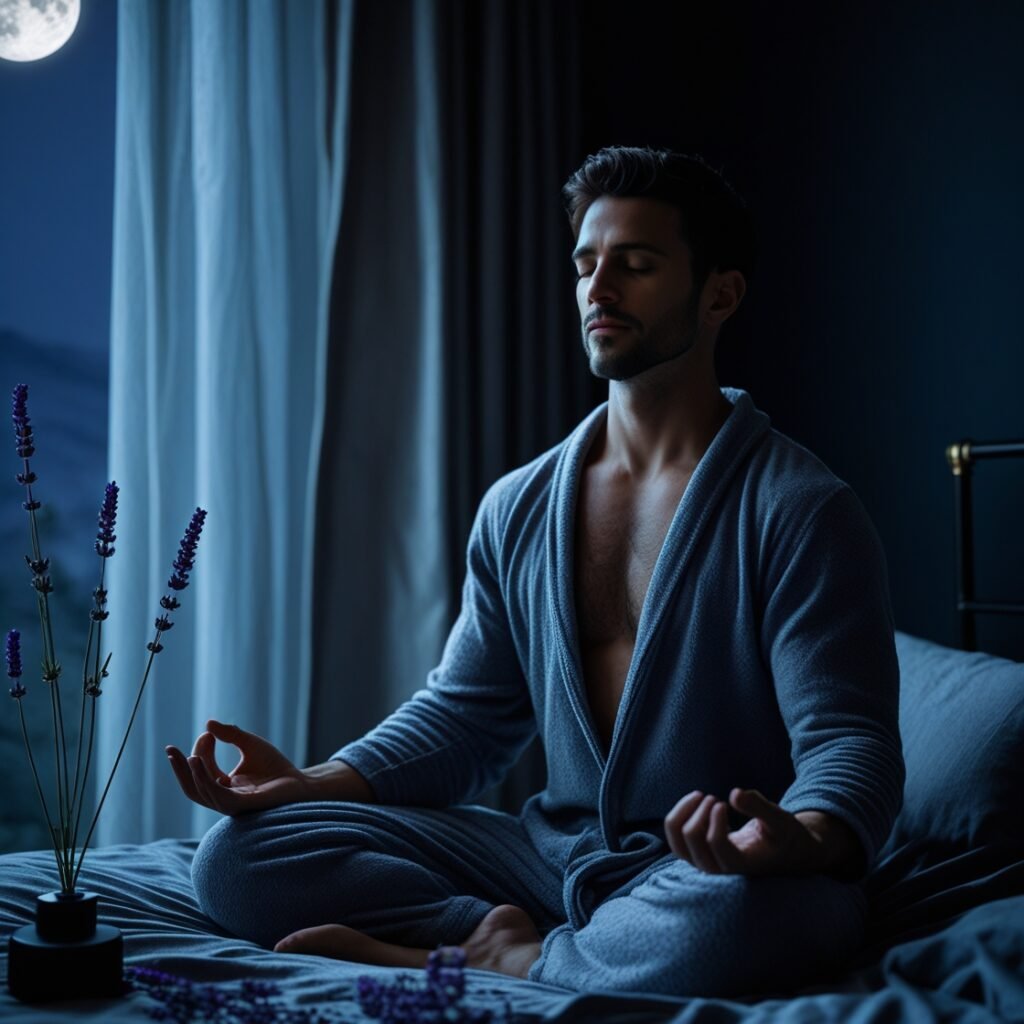Table of Contents
Introduction to Sleep Meditation
Struggling to Fall Asleep? How Meditation Can Be Your Secret Weapon for Deep, Restful Nights
You’re exhausted, your head hits the pillow, but your mind refuses to quiet down. Sound familiar? Millions of people face the same nightly battle—tossing, turning, and watching the clock tick away precious hours of sleep. But what if the solution wasn’t another pill or gadget, but something far simpler and more natural?
Meditation has long been praised for reducing stress and improving focus, but its power to transform sleep is often overlooked. By calming the nervous system and easing the mind into a state of deep relaxation, meditation can help you drift off faster, sleep more soundly, and wake up truly refreshed. Whether you’re new to meditation or a seasoned practitioner, the right techniques—paired with a supportive environment—can make all the difference.
In this guide, we’ll explore how meditation rewires your brain for better sleep, break down the most effective techniques (no incense or chanting required!)of sleep meditation, and share practical tips to overcome common roadblocks. Ready to finally reclaim your nights? Let’s begin.
Understanding the Connection Between Meditation and Sleep
Ever wonder why some people drift off effortlessly while others spend hours staring at the ceiling? The answer might lie in what’s happening before you even get into bed. Meditation isn’t just about finding inner peace—it’s a powerful tool to rewire your brain for deeper, more restorative sleep.
How Meditation Calms the Mind for Better Sleep
When stress and overthinking take over, your body stays stuck in “fight or flight” mode, making it nearly impossible to relax. Meditation works like a mental reset button by:
- Slowing racing thoughts – Instead of replaying the day’s worries, mindfulness teaches you to gently release them.
- Activating the parasympathetic nervous system – This signals your body that it’s safe to unwind, lowering heart rate and easing tension.
- Reducing cortisol (the stress hormone) – Studies show that regular meditation can lower cortisol levels, paving the way for natural drowsiness.
Think of it as a nightly brain detox—clearing mental clutter so sleep can take over.
The Science Behind Sleep Meditation
Skeptical? Research backs this up. Studies from Harvard and the National Institutes of Health reveal that meditation:
✅ Increases melatonin production – The hormone that regulates sleep-wake cycles.
✅ Enhances alpha and theta brain waves – Linked to deep relaxation and the twilight zone before sleep.
✅ Improves REM sleep – Critical for memory, mood, and overall restoration.
One study even found that participants who meditated fell asleep 20 minutes faster and stayed asleep longer than those who didn’t.
The Bottom Line: Meditation isn’t magic—it’s neuroscience. By training your mind to let go of stress, you create the ideal conditions for sleep to happen naturally. Ready to try it? Let’s explore the best sleep meditation techniques next.
Different Sleep Meditation Techniques to Improve Sleep Quality
Not all meditation is created equal—especially when it comes to sleep. The right technique can mean the difference between restless tossing and drifting off like a baby. So, which methods actually work? Let’s break down the two most effective styles for sleep, backed by science and sleep experts.
1. Guided Meditation for Deep Relaxation
Perfect for beginners (or anyone who struggles with a wandering mind), guided meditation is like having a soothing voice walk you into sleep. Here’s why it works:
- Structured relaxation – A narrator gently directs your focus away from thoughts and into bodily awareness (e.g., “Notice the weight of your limbs sinking into the mattress…”).
- Visualization techniques – Many guides incorporate calming imagery, like floating on a cloud or walking through a forest, to lull the brain into a sleepy state.
- No effort required – Unlike solo meditation, you don’t have to “do” anything—just listen and let go.
Try this: Apps like Calm or Headspace offer sleep-specific guided sessions, some even narrated by celebrities with voices like warm honey (looking at you, Matthew McConaughey).
2. Mindfulness Meditation to Quiet Racing Thoughts
If your bedtime struggle is a mental replay of awkward moments from 2012, mindfulness meditation teaches you to observe thoughts without getting tangled in them. The key steps:
- Focus on the breath – Inhale for 4 counts, exhale for 6 (longer exhales trigger relaxation).
- Notice thoughts, then release them – Imagine each worry as a cloud passing by. No judgment, just gentle redirection.
- Body scan – Slowly tense and relax each muscle group, from toes to forehead, to melt physical tension.
Why it works: A JAMA Internal Medicine study found that mindfulness meditation improved sleep quality better than sleep hygiene education alone. It’s like giving your brain permission to clock out.
Pro Tip: Pair these techniques with 4-7-8 breathing (inhale 4 sec, hold 7, exhale 8) for a knockout combo.
What’s Next? Even the best sleep meditation needs the right environment. Let’s set the stage for sleep success.
Creating the Right Environment for Sleep Meditation
You wouldn’t try to nap in the middle of a busy coffee shop, right? Yet many of us expect to practice sleep meditation in environments that are practically designed to keep us awake. The truth: where and how you practice sleep meditation matters just as much as the technique itself. Let’s transform your space into a sleep sanctuary.

Setting Up a Peaceful Sleep Space
Your bedroom should whisper “rest,” not scream “stress.” Here’s how to optimize it:
- Lighting: Dim the lights an hour before bed. If needed, try warm-toned salt lamps or blackout curtains to block disruptive blue light.
- Temperature: Science says 60-67°F (15-19°C) is ideal for sleep. A cool room mimics your body’s natural drop in core temperature at night.
- Clutter-Free Zone: Visual chaos = mental chaos. Clear nightstand piles and consider minimalist decor to promote calm.
- Scent: Lavender or chamomile essential oils (via diffuser or pillow spray) can reduce anxiety by up to 20%, per Frontiers in Psychology.
Pro Hack: Dedicate a corner for meditation—even if it’s just a cozy chair with a blanket. Over time, your brain will associate this spot with relaxation.
Best Times for Sleep Meditation for Optimal Sleep Benefits
Timing is everything. Here’s when meditation packs the biggest punch for sleep:
The 20-Minute Pre-Bed Window
- Meditating right before bed helps transition your nervous system from “go mode” to “slow mode.”
- Avoid screens afterward—opt for a book or light stretching instead.
The Midday Reset (For Chronic Insomniacs)
- A 10-minute mindfulness session after lunch can prevent stress from accumulating by bedtime.
The “I Woke Up at 3 AM” Emergency Session
- Keep a short, guided meditation on your phone (low brightness!) for nighttime wake-ups. Focus on breathwork instead of clock-watching.
Fun Fact: A Journal of Clinical Sleep Medicine study found that participants who combined evening meditation with an optimized sleep environment fell asleep 15 minutes faster than those who didn’t.
Ready to troubleshoot? Even perfect setups hit snags. Next, we’ll tackle common sleep meditation roadblocks—and how to glide past them.
Common Challenges About Sleep Meditation
Let’s be honest—even with the best intentions, meditation for sleep isn’t always smooth sailing. You might find yourself distracted, frustrated, or wondering if you’re “doing it wrong.” Sound familiar? Don’t worry; these hurdles are normal, and more importantly, fixable. Here’s how to navigate the most common struggles like a pro.

1. Dealing with Distractions During Sleep Meditation
Your mind wanders. The neighbor’s dog barks. Your phone buzzes. Suddenly, your “calm” session feels anything but. Before you give up, try these fixes:
Embrace the Wandering Mind:
- Instead of fighting distractions, acknowledge them (“Oh, there’s my to-do list again”) and gently return to your breath. This is the practice—not failure.
- Tip: Label thoughts as “thinking” and let them float by like clouds.
Minimize External Noise:
- Use white noise machines, earplugs, or nature sounds (rain, ocean waves) to mask disruptions.
- If sudden sounds startle you, try open-ear meditation—notice noises without reacting, as if they’re part of the background.
The “5-Senses” Trick:
- Ground yourself by noting:
- 1 thing you hear (e.g., your breath)
- 1 thing you feel (e.g., the pillow beneath you)
- 1 thing you smell (e.g., lavender)
…and let the other senses fade.
2. Staying Consistent with Your Sleep Meditation Practice
Consistency is key, but life gets busy. How do you make meditation stick?
Start Small:
- Commit to just 3–5 minutes nightly. Even brief sessions build the habit.
- Use habit stacking: Pair meditation with an existing routine (e.g., after brushing your teeth).
Track Progress Subtly:
- Note improvements in sleep quality (e.g., “Fell asleep faster tonight”) vs. rigid goals (“Must meditate 20 minutes”).
- Apps like Insight Timer offer streaks and reminders—but skip guilt if you miss a day.
Experiment with Formats:
- If seated meditation feels tedious, try:
- Walking meditation (slow steps pre-bed)
- Yoga nidra (“sleep yoga” done lying down)
- Journaling first (dump thoughts then meditate)
Remember: The goal isn’t perfection—it’s progress. Even Olympic athletes started with shaky first steps.
What’s Next? Let’s amplify your results with bonus practices that pair perfectly with sleep meditation.
Additional Practices to Enhance Sleep Meditation
Think of meditation as the foundation of your sleep routine—but sometimes, you need to reinforce it with extra support beams. These science-backed add-ons don’t just complement your practice; they can accelerate your journey to deeper, more consistent sleep. Ready to upgrade your wind-down ritual?
1. Combining Breathing Exercises with Meditation
Breathwork is meditation’s powerful sidekick—it physically cues your body to relax faster. Try these two potent combos:
- 4-7-8 Breathing + Body Scan:
- Inhale for 4 seconds
- Hold for 7 seconds
- Exhale for 8 seconds
- As you exhale, mentally release tension in one body part (start with toes → work upward)
Why it works: The extended exhale activates your vagus nerve, triggering instant calm.
- Box Breathing for Racing Minds:
- Inhale (4 sec) → Hold (4 sec) → Exhale (4 sec) → Hold (4 sec)
- Sync with a mantra like “Inhale calm, exhale chaos”
Bonus: Navy SEALs use this to sleep in high-stress environments—if it works for them…
Pro Tip: Pair these with guided meditations that incorporate breath cues (like Headspace’s “Sleepy Breathing” series).
2. Using Soothing Sounds or Music for Deeper Relaxation
Not everyone thrives in silence. Curated audio can be the bridge between frustration and flow:
Binaural Beats:
- Headphones required! Tones at slightly different frequencies per ear (e.g., 300 Hz left, 310 Hz right) encourage brainwaves to sync with sleep-friendly theta/delta states.
- Research shows they may reduce sleep latency by up to 35%.
Nature Soundscapes:
- Rainstorms, ocean waves, or forest ambience mask disruptive noises while tapping into evolutionary calm (our brains are wired to associate these with safety).
- Avoid looping tracks with sudden volume changes—look for seamless 8-hour versions.
Weighted Blanket Hack:
- While listening, add a 10-15 lb weighted blanket. The deep pressure stimulation mimics a hug, boosting serotonin and melatonin.
Fun Fact: A Journal of Sleep Research study found participants using binaural beats fell asleep 50% faster than the control group.
Final Thought: These aren’t just add-ons—they’re force multipliers. Experiment to find your perfect cocktail (maybe it’s box breathing + rainforest sounds + a weighted blanket). Sweet dreams are made of this.

Conclusion: Your Journey to Sleep Meditation Starts Tonight
Isn’t it remarkable how something as simple as breathing—something you’ve done your entire life—could be the missing key to unlocking restful sleep? Over the past few sections, we’ve explored how meditation isn’t just about sitting quietly; it’s a powerful, science-backed toolkit for rewiring your sleep cycle. From understanding the brain chemistry behind relaxation to creating your perfect sleep sanctuary, you now have everything you need to transform those frustrating nights into restorative retreats.
But here’s the most important takeaway: You don’t have to do it all at once. Start small. Maybe tonight, you’ll try just three minutes of mindful breathing before bed. Or perhaps you’ll swap out scrolling for a short guided meditation. Remember, even the most seasoned meditators began exactly where you are now.
Sleep isn’t a luxury—it’s the foundation of your health, mood, and energy. And with these tools, you’re not just hoping for better sleep; you’re creating it. So tonight, as you dim the lights and settle in, know that every breath, every moment of mindfulness, is a step toward waking up refreshed.
Which technique will you try first? Your future well-rested self is already thanking you.
References
- Harvard Medical School. (2021). Meditation and Sleep. Harvard Health Publishing. https://www.health.harvard.edu/blog/meditation-for-sleep-202110132614
- National Institutes of Health (NIH). (2019). Mindfulness Meditation Improves Sleep Quality. National Center for Complementary and Integrative Health. https://www.nccih.nih.gov/research/research-results/mindfulness-meditation-improves-sleep-quality
- Black, D. S., et al. (2015). Mindfulness Meditation and Improvement in Sleep Quality and Daytime Impairment. JAMA Internal Medicine, 175(4), 494–501. https://doi.org/10.1001/jamainternmed.2014.8081
- Frontiers in Psychology. (2018). Lavender Aromatherapy Reduces Anxiety. https://doi.org/10.3389/fpsyg.2018.01527
- Journal of Clinical Sleep Medicine. (2020). Meditation and Sleep Onset Latency. https://doi.org/10.5664/jcsm.8562
- Journal of Sleep Research. (2017). Binaural Beats and Sleep Efficiency. https://doi.org/10.1111/jsr.12580
- Kabat-Zinn, J. (2013). Full Catastrophe Living: Using the Wisdom of Your Body and Mind to Face Stress, Pain, and Illness. Bantam Books.
- Huberman, A. (2022). The Science of Breathing for Sleep. Huberman Lab Podcast. https://hubermanlab.com




